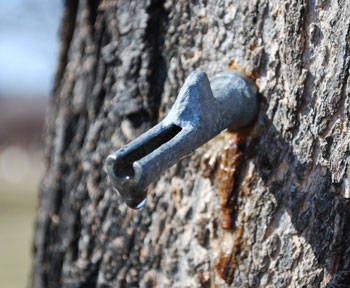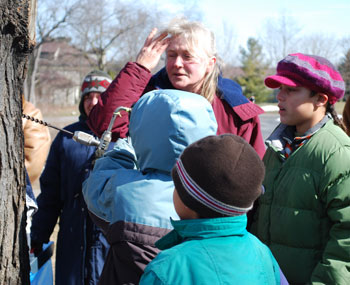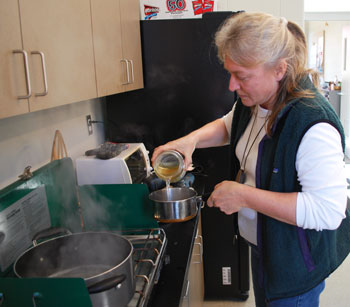Tapping Ann Arbor’s Sap

Sap starts to flow from a metal spile on a sugar maple tree at County Farm Park. The hump midway along the spile provides a place to hook your bucket and collect the sap.
A brutally cold wind buffets the group huddled around a sugar maple at the Washtenaw County Farm Park. They’re looking at a small metal device that’s been gently hammered into a hole drilled in the tree. Faye Stoner, a park naturalist for the county, sounds doubtful. “It’s probably too cold,” she says.
But wait – a kid in the group cries out: “It dripped … it dripped!” And sure enough, a globule slowly rolls off the end of the spout.
The maple sap is rising, and two dozen very cold people are learning about what Stoner calls “a gift from nature.”
We decided to sit in on Stoner’s Saturday class, called “Sap to Syrup,” after one of our readers filed a Stopped.Watched item about the “sapcicles” forming on maple trees across the city. How exactly does one tap the sap, we wondered? And then what happens?
Stoner describes the process as very simple: “It’s not easy, but it’s simple.”

Trees should be at least 10 inches in diameter before tapping. These kids are using wooden calipers to measure the trunk. It's plenty big.
Step 1: Know your trees
Someone asked whether you could make syrup from pine sap. Sure, Stoner replied, but “do we want turpentine on our pancakes or ice cream?” That would be “No” – so knowing which trees to tap is important.
The reason maple sap makes great syrup is that it contains a relatively high percentage of sugar, compared to other trees. “Relatively,” in that the maple sap is still about 97% water. Sugar maple is, as its name implies, the best for making syrup, though red and silver maples “will do in a pinch,” Stoner said.
Leaves are the easiest way to identify maples, but since tapping is done in the late winter, you’ll need other ways to locate the right tree. There are two key ways: 1) Sugar maple buds are pointy, not rounded; and 2) maples have “opposite growth pattern,” meaning that twigs shoot out from each side of the branch directly opposite each other.
The size of the tree is also important. Stoner uses the analogy of a dog and a puppy: Which one would be least harmed if you cut off its food supply? Like a puppy, young trees need more nourishment because they’re growing. So look for maple trees at least 10-12 inches in diameter. And the bigger the trunk, the more taps you can put in – up to three per tree – without harming the tree. Stoner warns: “Don’t overstress your tree by taking too much.”

Faye Stoner watches as one of the children in her "Sap to Syrup" class uses a hand drill to make a small hole in the silver maple tree. If you understand gravity, you'll know why they're drilling a hole angled this way.
Step 2: The two Ts (temp and tools)
Sap flow depends on temperature – the perfect time to tap sap is when nights are still cold but the days are getting warm, at least above freezing. Late February into March are typically when this occurs, and you’ll have about a six-week window to tap. As soon as the sap reaches the buds, it starts turning milky and bitter, and your season is over.
You need three things before you start: A tool to drill the hole in the tree, a tap or “spile,” and some kind of container to collect the sap. Stoner pointed people to two local sources for supplies: Downtown Home & Garden in Ann Arbor, and Dexter Mill.
Hand drills are old school, but if you’re tapping several trees you’ll likely want to use a cordless power drill, Stoner said. In either case, use a 7/16-inch drill bit.

This metal bucket with a sloped lid is a traditional container for collecting sap. The lid prevents rain (and deer) from getting into the sap.
Metal buckets that hook over the tap are the traditional way to collect sap – they come with sloped covers to prevent deer from snacking, and rain from diluting the sap. You can buy plastic sap bags designed specifically for that purpose, or an empty plastic milk jug works fine, too, Stoner said.
Step 3: Make your tap, collect your sap
You should drill at a slight upward angle, going only 2 to 2.5 inches deep. Clear out all the small wood chips from the hole, and insert your tap with a gentle, er, tap of a hammer. The metal tap is essentially a tube, and assuming conditions are right, you should soon see clear liquid start dripping out the end.
Stoner had tapped a nearby tree on Thursday, and collected her sap in a plastic milk jug. Whatever you use, make sure the container is securely affixed to the tree so that it won’t pull out the tap as the container fills and grows heavier.
When the days get warmer, you should collect your sap from the container every day to prevent bacteria from growing, Stoner said. Even when temperature isn’t a concern, it’s good to check the container frequently to make sure it doesn’t overflow. Sometimes you can get two gallons of sap within a 24-hour period, depending on how much sap the tree is producing. A single hole will typically yield 10 gallons of sap per season.

Faye Stoner pours sap into a small pan to boil it down into syrup. The sap she's pouring is amber, not clear, because it's already been partially reduced. The large pot on the left is sap that's in an early phase of being boiled down.
Step 4: Boil, boil, boil
Ten gallons sounds like a lot until you’re told that it takes 40 gallons of sap to make 1 gallon of syrup. Of course, you might also want to drink it straight: On Saturday, Stoner passed around small Dixie cups filled with sap she’d collected on Friday for people to sample. It tastes refreshing, like water that’s been spiked with sugar.
To get from this clear liquid to a dark amber syrup mostly requires time. Stoner suggests using a large pot for the first phase, and you can boil it 30-40 minutes without paying much attention. Beyond that, however, you need to keep a watchful eye. The closer sap gets to becoming syrup, the more likely it is to boil over or burn.
As the water evaporates, the liquid turns darker and thickens. The process can take quite a while, depending on how much you’re cooking. You’ll also see foam form on the top of the liquid while it’s boiling – it’s not harmful, Stoner says, but most people like to skim it off with a wooden spoon or strainer. Sometimes there’ll be other sediment, like bits of wood – you might want to strain the liquid through cheesecloth or some other kind of filter to get rid of that, she said.

Faye Stoner uses an eyedropper to put a sample of maple syrup she made on the hand of each person who attended her Saturday class. Why this method of distribution? For a large group, it's sanitary, fairly quick, and shows you how thick the syrup is, Stoner said.
Step 5: Eat and enjoy
Stoner had examples of several types of maple syrup on hand, including some she’d made. But she also held up bottles of Aunt Jemima and Log Cabin, saying, “These are not maple syrup!” To make her point, she read the ingredients: corn syrup, high fructose corn syrup, water, natural flavor (“But what kind of flavor?” she asked) sorbic acid and so on.
And what’s in real maple syrup? Do you really have to ask?
Everyone who attended Saturday’s class got to sample two kinds: Syrup made by Stoner, contained in an old mustard jar, and syrup from Snow’s Sugarbush in Mason, Mich. She dispensed samples onto each person’s hand, so you could see its consistency before licking it to taste. Her homemade syrup wasn’t as thick as the sample from Snow’s Sugarbush, but both were pretty darn rich and tasty.
At the end of the 1.5-hour class, Stoner asked how many of the people there planned to tap their trees. A few people, but not all, raised their hands. “If you don’t have a tree on your property, you can come take the sap from these trees,” she said. “Just call me.”
And by way of ending the class, Stoner had a final piece of advice: “Be kind to your trees. Don’t be greedy.”
Bonus: Maple Cocktail Recipe
3/4 oz. pure maple syrup
3/4 oz. dry gin
1 oz. lemon juice
1 oz. bourbon
(Serves one)




I’m so glad you gave further coverage to the breaking news of maple sap! The sapcicles are a bonus, and probably there will many the next few days. The sap flows and drips out of the tree naturally – and with this weather it will freeze. Break it off and there is your treat. I have found them just out walking, they look like icicles but in unlikely places on the tree, and the bark is often dark nearby from the dripping sap.
The weather has likely put a hold on sap collecting until Tuesday. But this is an urban project anyone can enjoy.
When you boil off the sap, run your exhaust fan, as the humidity is high during the boiling process. Or better still, outside on a propane stove or grill.
I have about a quart of precious syrup so far.
One of my favorite treats is to use the pure sap instead of water for making oatmeal in the morning. It can also be used for baking, in soups, etc.
Thanks for letting people know that maple sugaring isn’t just an “up north” activity. It can be a sweet reward for urban foraging!
I have fond memories of visiting the sucrerie (sugar shack in French) in my parent’s home town in Quebec. It was always so cold outside but warm, humid and fragrant inside! Try boiling the maple syrup down further and then pouring it still hot into snow to make a delicious toffee textured maple treat!
I grew up on a street in Ann Arbor that was lined with maple trees and we tapped them every year to make syrup. It was a really fun spring tradition. I highly recommend boiling the sap down outside! We didn’t one year and ended up with a kitchen absolutely covered in a light film of stickiness that was almost impossible to get off.
It wasn’t until I moved to Colorado that I realized not everyone has ready access to real maple syrup. It is a huge luxury in a lot of places in the country. We are lucky here in the north to have maple syrup so available and so inexpensively. Plus it is easy for us to get maple candy, maple sugar (which makes amazing cotton candy), and other really yummy maple food.
The Snow’s Sugarbush Maple Festival (http://snowssugarbush.com/festival.htm) is a fun excursion and a good excuse to eat a lot of maple syrup!
I used to tap about a dozen trees on my “hobby farm” in Hillsdale County. The maple syrup was good but the real benefit came from spending three or four weekends absolutely alone in the woods while collecting sap and the firewood needed to boil off the sap atop old oil drums. It was worth many thousands of dollars of psycho-therapy to me.
Brands like Aunt Jemima and Log Cabin no longer even claim to be “maple-flavored syrup,” they’re now called “breakfast syrup,” “pancake syrup,” or something along those lines.
the typical source of artificial maple flavor is fenugreek. there was reporting in the new york times recently about a maple syrup smell wafting over manhattan, which was traced to a new jersey flavor factory.
The visitor center out at the Waterloo Recreation Area has had a great maple sugar demonstration in past years. I don’t know if they’re doing it this year. The full name of the place is the Gerald E. Eddy Discovery Center. It’s a nice little natural history and geology center, near Chelsea.
link
Followup: it looks like the Discovery Center at Waterloo isn’t doing sugaring this year, though they do have lots of other events. Here’s a pdf with a schedule:
link to PDF
However, the Metroparks definitely are doing sugaring, every weekend in March!
link to schedule